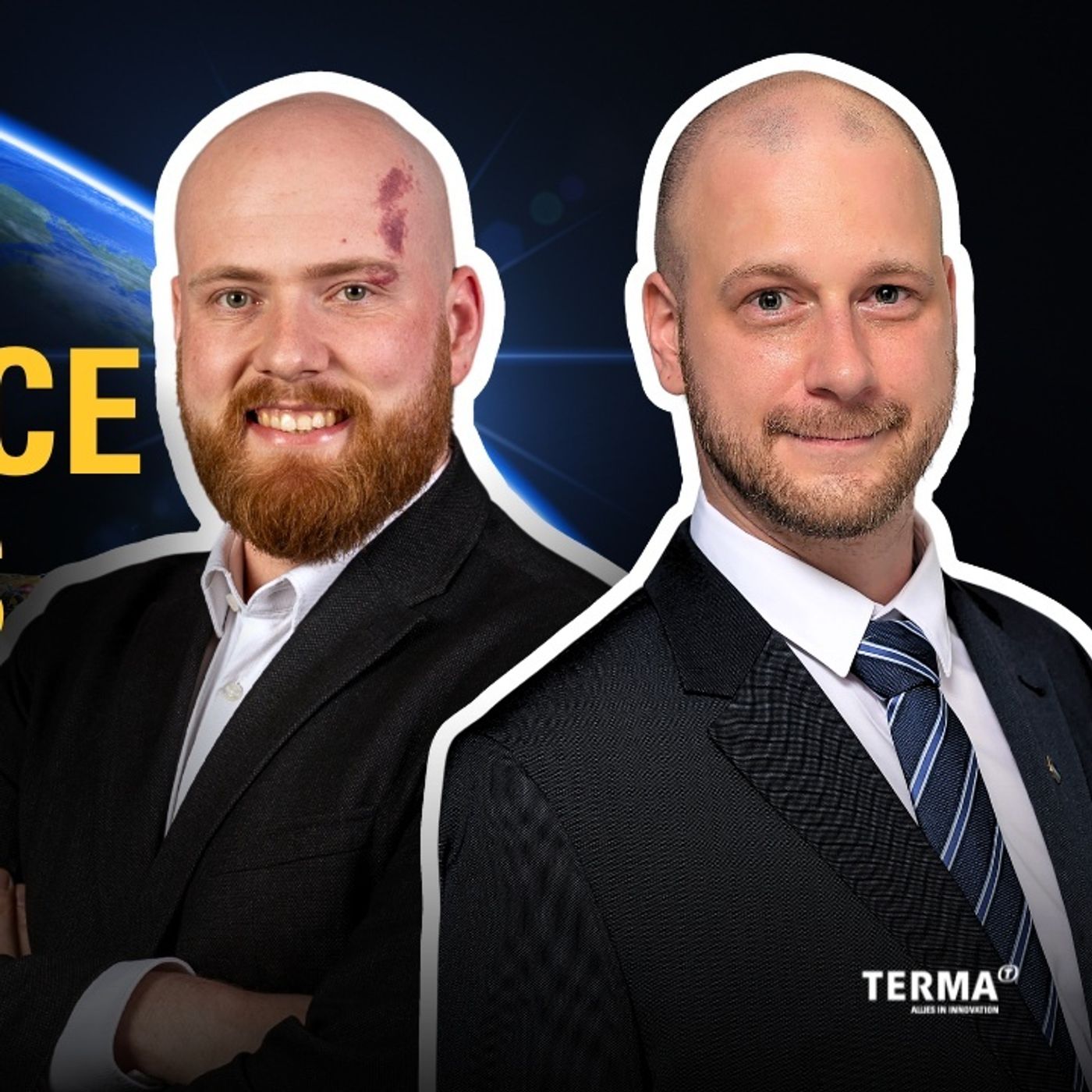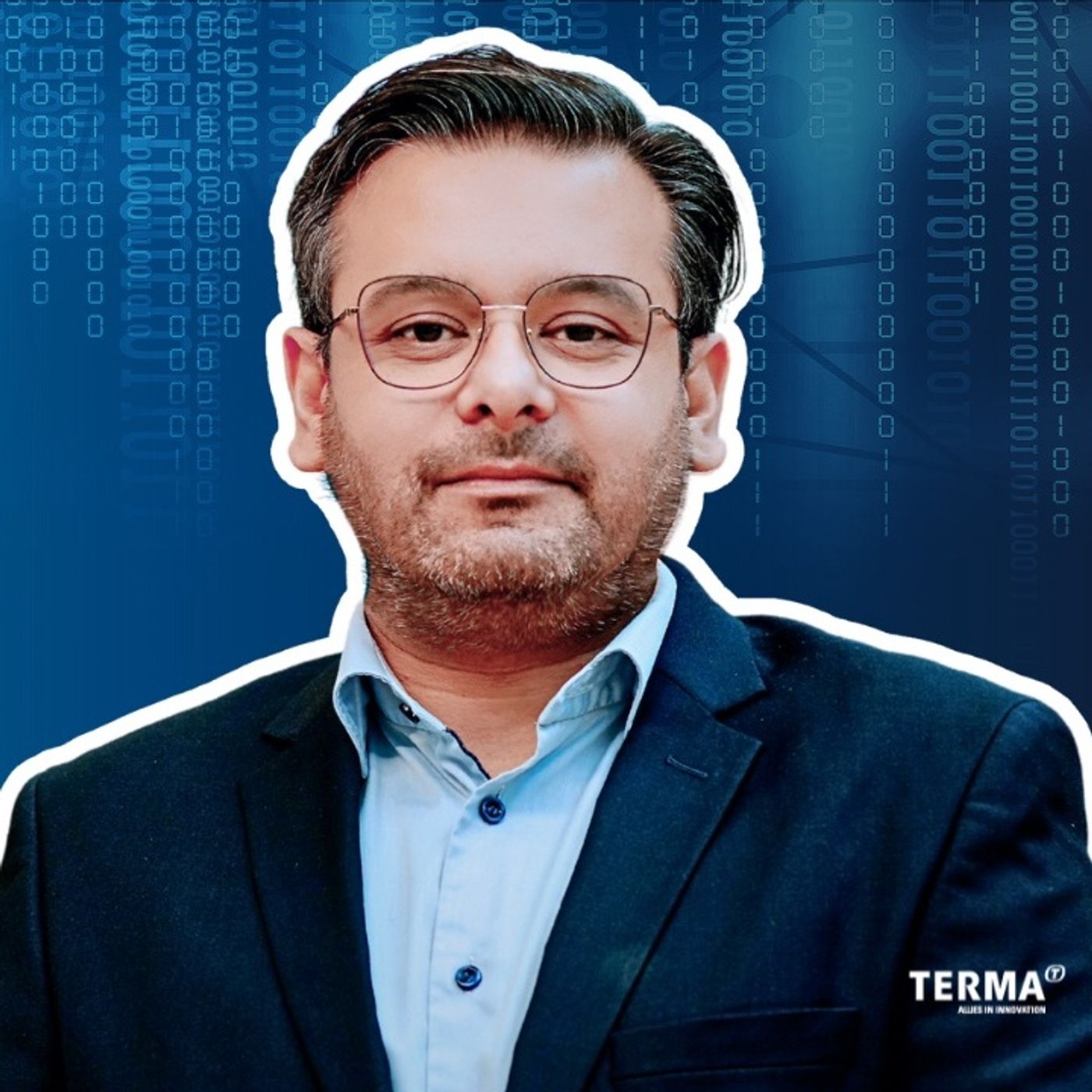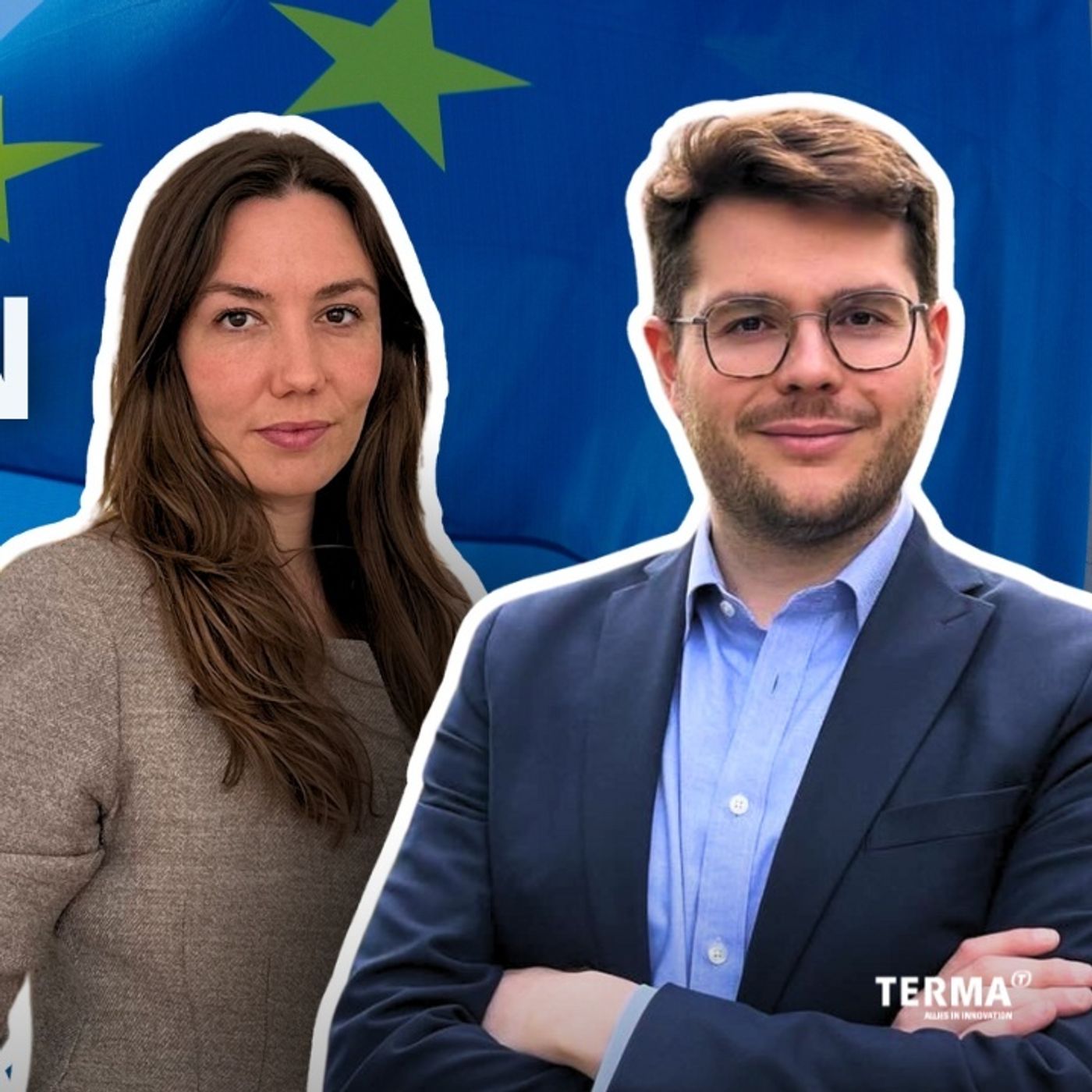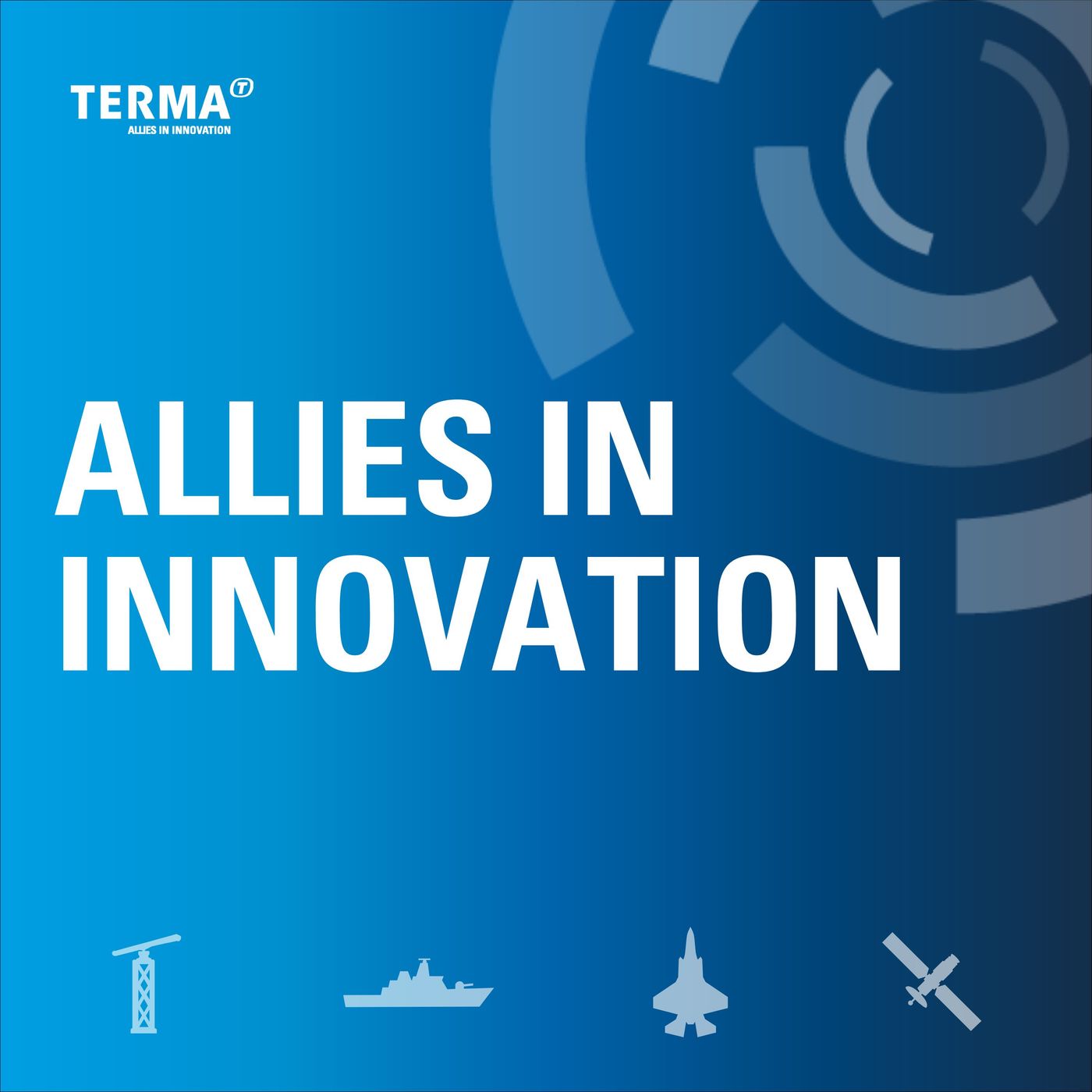Discover Allies in Innovation
Allies in Innovation

Allies in Innovation
Author: Terma A/S
Subscribed: 0Played: 3Subscribe
Share
© Terma A/S
Description
Allies in Innovation is the podcast that reveals some of the most advanced technologies on the planet. Technologies that will not only fascinate you but will change how you live your everyday life and ultimately change the world.
In the podcast we talk with the engineers behind the technological innovations, and we ask them, why it fascinates them and how it will come to change the future.
In the podcast, we’re zooming in on how to gain situational awareness of the Arctics, how to drive innovation in cutting-edge technology, and how to build for space.
So, join us today, as we dive into the innovations and partnership that will shape the future of space exploration, surveillance, and warfare.
This podcast is brought to you by Terma.
This podcast is produced by Montanus.
In the podcast we talk with the engineers behind the technological innovations, and we ask them, why it fascinates them and how it will come to change the future.
In the podcast, we’re zooming in on how to gain situational awareness of the Arctics, how to drive innovation in cutting-edge technology, and how to build for space.
So, join us today, as we dive into the innovations and partnership that will shape the future of space exploration, surveillance, and warfare.
This podcast is brought to you by Terma.
This podcast is produced by Montanus.
18 Episodes
Reverse
How do you keep communication systems in space agile, secure, and mission-ready? Software-defined radio (SDR) might be your best answer.In this episode of Allies in Innovation, host Mikkel Svold talks with Andreas Stren, lecturer at the University of Applied Sciences Wiener Neustadt, and Alexander Spaniol, RF engineer at Terma. They break down how SDR shifts control from hardware to software, enables remote updates, faster adjustments to mission demands, and better risk management.They also get into real-world SDR use cases, cybersecurity challenges, and why the tech could be a game-changer for ground stations and smaller space operators.If you’re into the current or future space communication systems, this one’s worth a listen.In this episode, you'll learn about:Key benefits of software-defined radio in space missions.How SDR enhances flexibility and re-configurability for satellites.Overcoming SDR challenges: radiation effects and cybersecurity.The role of virtualization in satellite communication solutions.Future prospects: cost-effective and accessible ground stationsEpisode Content00:00 Introduction to Software-Defined Radio and Guests 00:47 What is Software-Defined Radio (SDR)? 01:43 Transition from Hardware to Software-Defined Systems 03:15 Advantages of Reduced Hardware in Space Missions 05:39 Flexibility and Reconfigurability in SDR Applications 08:12 Risks and Challenges of Using SDRs in Space 12:33 Cybersecurity Concerns in Software-Defined Systems 14:07 Connection Between SDR and Virtualization 16:22 Cost-Effectiveness of Virtualized Ground Stations 17:22 Educational Impact of SDR in Aerospace Training 28:42 Future Trends in SDR for Communication ServicesProductionThis podcast is brought to you by Terma.This podcast is produced by Montanus.ProductionThis podcast is brought to you by Terma. This podcast is produced by Montanus.
A drone buzzes low over a restricted zone. It’s too small to spot on radar, too fast to intercept in time. It’s not science fiction. It’s happening right now, at nuclear plants, power grids and government offices.In this episode, host Mikkel Svold talks with Karsten Marrup from the Royal Danish Defense College and Lasse Due Jørgensen from Terma, a global leader in drone defense tech. They break down how drones are pushing past old security systems and what’s actually working to stop them.We get into real-world tactics, the limits of current tech and how AI fits into the picture. The future has arrived faster than expected, and it’s up to us to meet it head-on.In this episode, you'll learn about:1. Types of drones national security must counter.2. Why different drones need different countermeasures.3. How critical infrastructure protects against drone threats.4. Impact of hybrid warfare on critical infrastructure.5. Challenges of leveling the field with scalable counter systems.6. Role of AI in evolving drone threats.Episode Content 01:55 Different types of drones and their purposes06:18 Drones for critical infrastructure protection08:00 Understanding motives behind drone activities09:24 Challenges in detecting and countering drones11:00 Radar limitations for small drones explained13:53 Building a layered defense approach17:27 Prioritizing critical infrastructure protection strategies19:48 Mitigating threats from cheap drones22:45 Importance of passive air defense measures26:16 Exploring hybrid warfare and its implications29:47 Cybersecurity and space operations questions to consider34:15 Future of drone technology and defense strategieProductionThis podcast is brought to you by Terma. This podcast is produced by Montanus.
Cyber security is no longer an afterthought. Cyber threads are now shaping the foundation of defense and critical infrastructure systems. At the same time, emerging technologies like quantum computing and AI are accelerating faster than expected, bringing both opportunities and risks.In this episode of Allies in Innovation, host Mikkel Svold sits down once again with Samant Khajuria, Vice President of Quantum and Cyber at Terma. They revisit the evolving cyber landscape, explore how defense organizations are preparing for “Q-Day” (when quantum computers can break today’s encryption), and discuss the crucial role of collaboration in staying ahead. They also cover practical challenges, from legacy systems to shifting standards, and explain why cyber needs to be integrated from the very first design stage and not added later.If you want to understand how the defense industry is gearing up for disruptive technologies, this episode will give you a front-row seat.In this episode, you'll learn about:Why cyber is moving from “add-on” to a core design requirement.How NATO standards are shaping interoperability across defense systems.The convergence of cyber, AI, and quantum - and the risks of misuse.The looming quantum threat: “harvest now, decrypt later.”How post-quantum cryptography and quantum key distribution could secure the future.Real-world challenges in transitioning legacy systems.The importance of partnerships and joint strategies in Europe and beyond.Why quantum sensing might become a game-changer in the next five years.Episode Content00:00 Introduction to Cyber and Quantum with Samant Khajuria01:54 Cybersecurity as a fundamental requirement in defense and infrastructure03:29 The shift from “add-on” security to built-in resilience05:41 Disruptive technologies: cyber, AI, quantum, and their dual-use risks08:58 Collaboration and partnerships to keep pace with rapid innovation09:38 Preparing for Q-Day: harvest now, decrypt later10:52 Post-quantum cryptography and quantum key distribution in practice12:47 Challenges of legacy systems and new cyber standards15:09 Roadmap: proof-of-concepts and quantum key exchange projects16:42 How smaller organizations can prepare for cyber and quantum threats18:06 Quantum sensing and other non-cyber applications of quantum tech19:40 Looking ahead: strategy, digitization, and reducing red tapeProductionThis podcast is brought to you by Terma. This podcast is produced by Montanus.
Is Europe ready for the next wave of security threats?With Denmark stepping into the EU presidency and war still raging in Ukraine, defense strategy across the continent is under pressure to adapt. In this episode, host Mikkel Svold speaks with Christine Nissen, Chief Analyst at Think Tank Europa, and Séverin Schnepp, Associate Director at Terma, to uncover Denmark’s growing role, the EU’s shifting posture, and defense industry readiness.Can Europe act together?Are current capabilities enough?And what should the defense sector expect?**In this episode, you'll learn about:**Denmark's EU presidency and its impact on European security.How EU defense policies are shaped during presidencies.Denmark's shifting stance on EU defense cooperation.Balancing conventional and unconventional security threats in Europe.Industry and government roles in defense capability development.Importance of collaboration in European defense strategies.## Episode Content01:17 Overview of EU Presidency and its significance03:04 Influence of Denmark on the EU agenda05:12 Historical skepticism of Denmark towards EU defense09:30 Industry perspective on changing defense dynamics13:05 Public sentiment regarding EU defense cooperation15:39 Upcoming agendas for Denmark's EU Presidency18:43 Budgeting goals and legislative conclusions for defense21:51 Ready for conflict by 2030: key concerns25:17 Addressing conventional and unconventional threats31:38 Future of European defense collaboration strategies34:47 Top priorities for Denmark during the presidency## ProductionThis podcast is brought to you by Terma.This podcast is produced by Montanus.ProductionThis podcast is brought to you by Terma. This podcast is produced by Montanus.
Europe’s defense priorities are shifting fast – but are governments moving quickly enough?Join us at the Paris Air Show where we talk with Georgia Pickering from CMS Strategic and Steen Lynenskjold of Terma about how the UK and Denmark are responding to rising tensions, urgent rearming pressures, and what NATO and the EU are getting right – and wrong.In this episode You’ll learn about the funding gaps, where skills and tech still fall short, and how politics, industry, and the military are actually working together to meet Europe’s 2030 defense goals.Short, sharp, and brutally honest.In this episode, you'll learn about:The impact of defense budget increases in Europe and NATO.The UK's current stance and future on defense spending.How the Danish defense industry is responding to new demands.The role of SMEs in strengthening the defense sector.Innovations and challenges in European defense investments.How non-traditional companies are changing the defense landscape.Episode Content01:41 Discussion on Europe's rearming urgency06:00 Addressing capability and skills gaps in defense07:32 Perception shifts due to support for Ukraine09:54 The importance of industry certainty and investment10:55 Accelerating defense capabilities within the industry15:52 The blurring lines between civil and defense industries19:26 Non-traditional companies entering the defense sector22:52 Launch of new technology during the air show30:00 Closing remarks and listener engagement invitationProduction This podcast is brought to you by Terma.This podcast is produced by Montanus and LoudColors.Special thanks to Paris Air Show and CMS Strategic for joining the conversation.ProductionThis podcast is brought to you by Terma. This podcast is produced by Montanus.
How do nations protect their most critical systems in an increasingly digital world? In this episode of Allies in Innovation, host Mikkel Svold talks with Samant Khajuria, VP of Cyber and Quantum at Terma, and Jeffrey Saunders, CTO and Strategic Advisor at Denmark's National Defense Technology Center.They break down how governments, researchers, and the private sector work together to tackle cybersecurity challenges. From securing supply chains to tackling real-world defense threats, the conversation gets straight to what works—and what doesn't—when safeguarding national networks.Listen in to learn how collaboration, trust, and constant vigilance are shaping the future of cyber defense.In this episode, you'll learn about:1. How collaboration strengthens cyber defense across industries.2. The critical role of supply chain security.3. Key certifications for robust cyber defense.4. The intersection of IT and OT in cybersecurity.5. How trust and verification impact national defense.6. Insights into future collaboration for cybersecurity innovation.Episode Contents00:11 Introduction to Cybersecurity in Defense with Samant Khajuria and Jeffrey Saunders 03:24 Building Trust Within Your Supply Chain 08:18 Ensuring Compliance Across Vendor Supply Chains 10:21 Integrating IT and OT for Enhanced Security 15:42 Collaboration Among Governments, Research, and Private Sector 17:36 Education and Knowledge Sharing in Cybersecurity 29:25 Future Collaborations and Building Trust Across Borders 32:59 Final Thoughts on Trust and Verification in CybersecurityProductionThis podcast is brought to you by Terma.This podcast is produced by Montanus.ProductionThis podcast is brought to you by Terma. This podcast is produced by Montanus.
Space hardware is getting a software upgrade — and it’s changing the rules.In this episode, Mikkel Svold speaks with aerospace lecturer Andreas Stren and RF engineer Alexander Spaniol from Terma about how configurable tech like FPGAs is giving satellites a second life. Smarter systems mean in-mission updates, greater resilience, and real-time adaptability in unpredictable environments.For those tracking the edge of space infrastructure — from mission ops to defense contractors — this conversation cuts to the core of what's next in agile satellite design.This is about what’s working, what’s coming, and why it matters.In this episode, you'll learn about:Discover how software redefines space tech design and functionality.Understand FPGA's role in software-driven space applications.Learn the shift from hardware to software-defined architectures.Explore mission agility with software reconfigurability onboard.Uncover how AI enhances satellite autonomous decision-making.Future vision: virtualization and onboard data processing evolution.Episode Contents00:11 Introduction to software's evolution in space technology 01:06 Historical shifts: From analog systems to software-driven solutions 03:29 Role of software-defined architectures in space systems 04:53 Hardware requirements in harsh space environments 07:24 Enhancements in mission planning and satellite lifespan 10:52 Implications of increased processing power for satellites 13:28 Benefits of software-defined systems for mission adaptability 17:56 Automation and AI in satellite decision-making processes 22:13 Influence of new space actors on software advancements 25:21 Future developments: Virtualization and onboard data processing 28:50 Practical applications: Wildfire detection and autonomous landingsProductionThis podcast is brought to you by Terma.This podcast is produced by Montanus.ProductionThis podcast is brought to you by Terma. This podcast is produced by Montanus.
Why is collaboration in space still so difficult? Despite high-profile partnerships like the ISS, geopolitical tensions, intellectual property disputes, and commercial interests often get in the way. In this episode of Allies in Innovation, host Mikkel Svold talks with Kartik Kumar, CEO of satsearch, and Manfred Otto, Senior Director at Terma, about what’s really driving – and blocking – cooperation in the space industry. They cover the challenges of working across borders, how commercialization is reshaping partnerships, and the impact of AI and cybersecurity on collaboration. For those navigating this high-stakes landscape, this is a conversation worth hearing.In this episode, you'll learn about:1. Why collaboration isn't always seamless in the space industry.2. Commercial off-the-shelf in space: reality or aspiration?3. Navigating complexities like export control and IP in partnerships.4. Impact of commercialization: driving standardization or commoditizing?5. Is space heading for a Wild West gold rush?Episode Content00:12 Introduction: Collaboration Challenges in the Space Industry 01:23 Observations on Industry Collaboration and Competition 02:41 Navigating Cross-Border Partnerships and Exhausting Legal Complexities 03:45 The Complexity of Satellite Production and Operations 06:15 Balancing Innovation with Regulatory Constraints 09:47 The Role of Smaller Companies in a Complex Ecosystem 13:08 Export Control and Compliance in Space Projects 17:40 Predicting the Future Demand in the Space Market 24:13 Trends Driving Commercialization in the Space Sector 30:45 Need for Standardization and Modular Approaches in Space Products 39:15 Making Space Accessible: The Future of Talent AcquisitionProductionThis podcast is brought to you by Terma This podcast is produced by Montanus.ProductionThis podcast is brought to you by Terma. This podcast is produced by Montanus.
Is the maritime industry finally ready to go fully digital, or is tradition keeping it anchored in the past? While aviation has embraced high-tech solutions, shipping has been slower to adapt. Autonomous vessels, AI-driven radar, and e-navigation promise a safer, more efficient future—but what’s standing in the way? Host Mikkel Svold talks with Peter Roelofs, Senior Sales Manager at Terma, and Francis Zachariae, Secretary General at IALA, about the hard realities of digitalizing the global marine sector. From fragmented regulations to the challenges of integrating cutting-edge tech, they break down what’s holding the industry back—and what needs to happen next. How can digital systems prevent collisions, cut emissions, and streamline operations across the globe? And can the maritime sector finally catch up with aviation? Listen in to find out.In this episode, you'll learn about:1. Discover the challenges slowing marine digital transformation.2. How e-navigation can reduce maritime emissions by 38%.3. Learn what VTS systems mean for port navigation efficiency.4. Why autonomous ships might not happen for 20-30 years.5. The importance of harmonization in global maritime solutions.6. Future perspectives: AI in marine radar classification.Episode Content00:11 Introduction and guests: Peter Roelofs and Francis Zachariae 02:16 The need for digital transformation in the maritime sector 04:01 Comparing digitalization in aviation vs. maritime 05:47 E-navigation: A safety and efficiency revolution 08:37 Defining e-navigation and its benefits for shipping 11:57 Challenges in linking marine navigation systems 13:31 Overview of Vessel Traffic Services (VTS) 22:12 The push for efficiency and sustainability in shipping 27:44 Future of automation and autonomous vessels in maritime 32:53 Essential steps for advancing maritime digitalizationProduction This podcast is brought to you by TermaThis podcast is produced by MontanusProductionThis podcast is brought to you by Terma. This podcast is produced by Montanus.
How secure is your IT infrastructure—really? Are you confident it’s not a breach waiting to happen?In this episode, we talk with Samant Khajuria, VP of Cyber and Quantum at Terma, and Jeffrey Saunders, CTO at Denmark's National Defense Technology Center. They break down the realities of today’s cyber threats, from sophisticated attacks on critical infrastructure to the impact of AI and quantum computing on cybersecurity.Learn how these evolving threats are reshaping the way we think about defense—and what you can do to stay ahead. Hear why trust and collaboration are more than buzzwords; they're your best lines of defense.In this episode, you'll learn about:1. How cyber threats have evolved alongside digital transformation.2. The impact of hybrid warfare on critical infrastructure defense.3. Operational security with interconnected personal devices.4. Strategies for integrating private and national cyber defense.5. Emerging cyber threats: AI, quantum computing, and trust dynamics.Episode Content00:04 Introduction to Cyber Threats and Evolving Defense Strategies 01:38 Definition of Cyber Threats and How it’s Redefined Today05:21 Shift from Closed to Open Systems in Defense 08:29 Direct vs. Insider Threats: Evolving Challenges 12:17 Mitigating Risks in National Cyber Responsibility 16:08 Importance of Private Sector Collaboration 19:02 Understanding the Diverse Motivations Behind Cyber Attacks 25:44 Emerging Trends: AI and Quantum Computing ThreatsProductionThis podcast is brought to you by Terma.The podcast is produced by Montanus. ProductionThis podcast is brought to you by Terma. This podcast is produced by Montanus.
After three years, the Farnborough International Airshow finally returns. Terma is part of the long-awaited trade exhibition, showcasing the newest innovations within the aerospace and defense industries, Terma is proud to present their Multi Mission Pod and several other groundbreaking inventions.To shed light on today’s topic, two Terma-veterans of the annual airshow will be joining the podcast to explain why Farnborough International Airshow is such a big deal, and what to expect from the event. Listen to this episode if you want a peak into the one of the largest events within aviation and defense.Today's guests:- David Martin, Senior Vice President & General Manager at the Aeronautics division at Terma.– Steen Lynenskjold, Executive Vice President & Chief Commercial Officer at Terma.Your Host: Mikkel SvoldThis podcast is brought to you by Terma, www.terma.comThis podcast is produced by Montanus, www.montanus.coProductionThis podcast is brought to you by Terma. This podcast is produced by Montanus.
The Arctic region is under drastic change and so is the geopolitical situation. As the ice retracts, new resources are uncovered and accessibility increases. These changes create a new demand to maintain stability in the extreme environment, which is the topic of today’s episode.Not only is the Arctic an extremely vast area, but the remote location creates an array of technological challenges that must be met. How is this done and what is actually required to keep stability in the Arctic?Today's guests are: - Senior Vice President for Surveillance and Mission Systems at Terma, Thomas Blom- Managing Director at Naval Team Denmark, Nils WangThis podcast is brought to you by Terma, www.terma.comThis podcast is produced by Montanus, www.montanus.coProductionThis podcast is brought to you by Terma. This podcast is produced by Montanus.
The Arctic region has undergone an extreme development both geographically and politically. Recently, a new layer of complexity has evolved; Russia decided to invade Ukraine and China has shown interest in the arctic as the ice retracts. The question: What is going to happen in the Arctic?The changing environment not only impacts people, but also the changes raise a string of geopolitical challenges, which will be discussed in this episode.Today’s Guests:- Managing Director at Naval Team Denmark, Nils Wang- Senior Vice President for Surveillance and Mission Systems at Terma, Thomas BlomYour Host: Mikkel SvoldThis podcast is brought to you by Terma, www.terma.comThis podcast is produced by Montanus, www.montanus.coProductionThis podcast is brought to you by Terma. This podcast is produced by Montanus.
Today’s episode is a continuation of the last episode on innovation. It concerns how to facilitate innovation in large tech companies to ultimately create cutting-edge and innovative technologies.This episode focuses on how to facilitate innovation-practices as a tech company and answers the important question of how you get specialized experts to work together to create innovative solutions that work in real life.Listen to this episode to get a practical understanding of innovation, learn how Terma integrates innovation into their business model, and understand the difficulties in facilitating an innovative process.Today’s Guests: -Innovations Specialist at Terma, Annette Skyt-Professor of Innovation and Management and Staff Manager at Aalborg University, Jacob BrixYour Host: Mikkel Svold Produced for Terma by MontanusProductionThis podcast is brought to you by Terma. This podcast is produced by Montanus.
When working with defense and space an innovative mindset is a must, but new opportunities equal uncertainty. Trying to solve a classified problem involves enormous risks associated with the innovative process while finding the solution.There is an endless list of definitions of innovation. Today’s guest, Jacob Brix, sees innovation as a process. You find opportunities, elaborate on them, test them, make them work, and adopt them. Innovation means continuously looking for new opportunities marketwise and technologically. Innovation is all about finding the next invention worth pursuing.Listen to this episode to understand the importance of innovation. What makes it hard? Why is it that innovation makes Terma, and other organizations, continuously relevant?Today’s Guests: -Innovations Specialist at Terma, Annette Skyt-Professor of Innovation and Management and Staff Manager at Aalborg University, Jacob BrixYour Host: Mikkel Svold Produced for Terma by MontanusProductionThis podcast is brought to you by Terma. This podcast is produced by Montanus.
In today’s episode, we’re taking you into space to talk about a small but quite fascinating gadget called ASIM, which is short for Atmosphere-Space Interactions Monitor.ASIM is an observatory installed on the European Columbus module of the International Space Station (ISS) that monitors the high-altitude electrical discharges in the stratosphere and mesosphere above large thunderstorms.This joint project, led by the Technical University of Denmark (DTU) and Terma, has been developed for the European Space Agency (ESA). ASIM is the largest Danish space project to date.Today’s Guests: -Senior System Engineer and Manager of ASIM Engineering at Terma, Dan Bhanderi -Senior Scientific Advisor DTU Space, Torsten NeubertYour Host: Mikkel SvoldThis podcast is brought to you by Terma, www.terma.comThis podcast is produced by Montanus, www.montanus.coProductionThis podcast is brought to you by Terma. This podcast is produced by Montanus.
Today, no military operation would be possible without digital systems for communication, situational awareness, and rapid decision support.But what happens if your command-and-control system gets hacked? Or if someone prevents, eavesdrops, or even manipulates the flow of information between units in combat? Imagine what havoc an armed drone could do, if taken over by enemy forces.In this first episode of Allies in Innovation, we talk about, what cyber threats nations and companies are facing, and what counter measures are taken in the military industries to ensure a resilient cyber defense for our armed forces.Today’s Guests:-Chief Specialist in Cyber Security at Terma, Samant Khajuria-Cyber Exploitation Test Engineer at Lockheed Martin, Andre Cunningham-Cyber Architect at Lockheed Martin, Chris Sargent.Your Host: Mikkel SvoldThis podcast is brought to you by Terma, www.terma.comThis podcast is produced by Montanus, www.montanus.coProductionThis podcast is brought to you by Terma. This podcast is produced by Montanus.
Allies In Innovation is the podcast that reveals some of the most advanced technologies on the planet. Technologies that will not only fascinate you but will change how you live your everyday life and ultimately change the world. In the podcast we talk with the engineers behind the technological innovations and we ask them, why it fascinates them and how it will come to change the future. Throughout the podcast, we’re zooming in on situational awareness of the Arctics, special composite material for the F35 fighter jet, AI-induced systems for rapid decision-making, how to build critical components for satellites, and much much more. So, join us today, as we dive into the innovations that will shape the future of space exploration, surveillance, and warfare. This podcast is brought to you by Terma, www.terma.comThis podcast is produced by Montanus, www.montanus.coProductionThis podcast is brought to you by Terma. This podcast is produced by Montanus.









